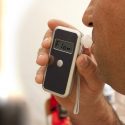
Today’s ignition interlock devices are very accurate and reliable. That’s because they use what are called alcohol fuel sensors. These sensors are specifically designed to detect even the tiniest amount of alcohol.
In order for a state to approve an interlock vendor such as ALCOLOCK™, our ignition interlock devices must meet or exceed the National Highway Transportation Safety Administration (NHTSA) model specifications for breath alcohol ignition interlock devices (BAIIDS). Those specifications set parameters for the lowest amount an interlock can measure, and how reliably accurate a device must be before it can be used.
The Minimum Amount of Alcohol an Interlock Can Detect
The minimum is zero blood alcohol content (BAC). An interlock device must reliably be able to detect that there is no alcohol on your breath and allow you to start your vehicle, or continue driving normally after a rolling retest.
The Warning Range
The next range of alcohol an interlock can detect is a small amount of alcohol considered to be in the Warning range. All 50 states and Washington DC have ignition interlock laws but vary between .02 and .025 breath alcohol content (BAC) as the set point at which the device will register that you failed the test, and lock you out.
If the device detects you have alcohol on your breath, but less than the setpoint, it will give you a warning light and warning message. The device will record that while you did not fail the test, there was alcohol present on your breath.
The Set Point
Any BAC above the state set point means you failed the ignition interlock breath test. Each state has its own rules about how many startup tests you can fail during a certain time period before you face penalties. If you fail a rolling retest, it is an automatic violation of your program rules. That makes you subject to penalties immediately. Again, each state program differs. You will want to refer to your program rules to determine exactly what will happen when you fail one or more breath tests.
High-Level BAC
Some ignition interlock devices such as the ALCOLOCK™ V3 can record BAC levels up to 1.0. Keep in mind, for all states 0.08 is the general BAC at which you would be charged with DUI/DWI. A BAC of 1.0 would result in more serious charges. If you were to blow a 1.0 on your ignition interlock device, not only would the device lock you out, but it would record the information to notify your monitoring agency. In many cases, states require interlock vendors to report test failures like this in near real-time. At the very least, we must report it within 24 hours.
And if your state requires real-time reporting with GPS, they could feasibly send a law enforcement officer to your location to arrest you for drunk driving.
The Bottom Line
The bottom line is that ignition interlock devices are very sensitive to alcohol and highly accurate. Don’t attempt to take the breath test if you’ve been drinking, because you will fail or get a warning. Both of those count against you in your restricted driving program.
If you’ve had something to drink, catch a ride home with a friend or call an Uber/Lyft. Or take public transportation. Just don’t get behind the wheel yourself. It’s not safe, it’s against the law, and it’s not worth it.
Schedule Your Ignition Interlock Device Installation
ALCOLOCK™ strives to make your ignition interlock device installation easy and affordable. We have service locations in states across the country to serve you. Simply call the service center most convenient to you to schedule your IID installation. You can also call ALCOLOCK™ directly at (866) 700-9300 and we will help you get scheduled.
Someone else will need to drive you and your vehicle to your appointment, which will last about an hour. Once the technician installs the interlock device and trains you how to use it, you will schedule your first service visit. Then, you are free to drive, according to the rules laid out in your restricted driving program. For some states that means any time, anywhere. For others, you may be restricted to daytime hours, or driving to and from work or school, for instance.
Service visits are required by state law and will take about 20 minutes. Depending on what state you live in, you will need to come in for regular maintenance visits every 30-60 days. Your restricted driving program rules will detail all of that. Your technician can answer most of your questions as well.